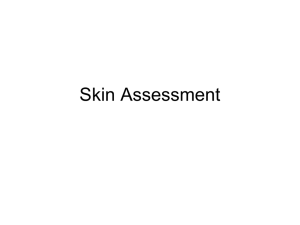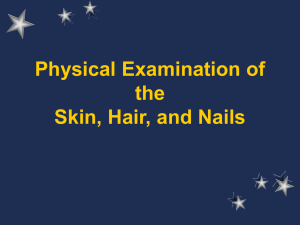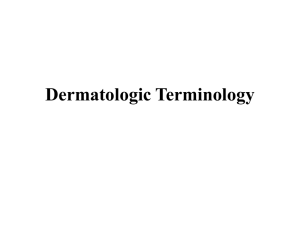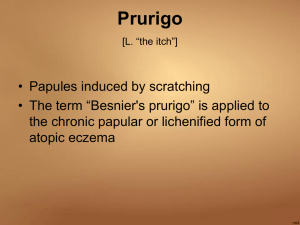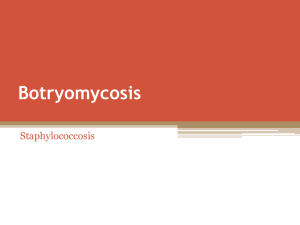PHYSICAL DIAGNOSIS LECTURE – THE SKIN EXAM
advertisement
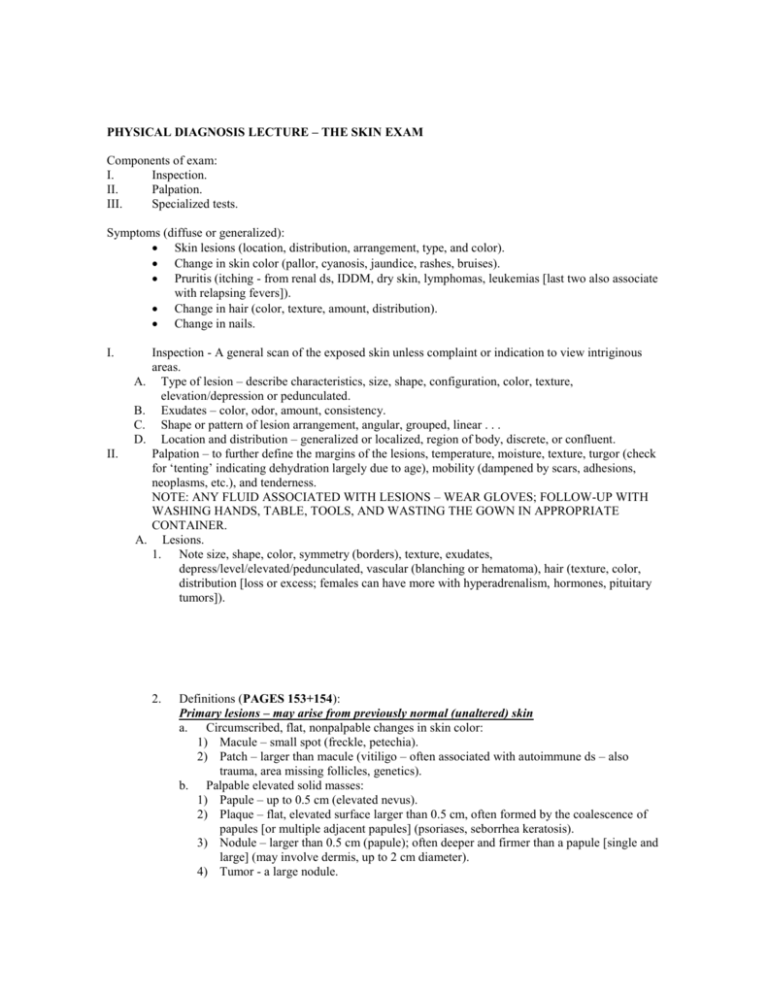
PHYSICAL DIAGNOSIS LECTURE – THE SKIN EXAM Components of exam: I. Inspection. II. Palpation. III. Specialized tests. Symptoms (diffuse or generalized): Skin lesions (location, distribution, arrangement, type, and color). Change in skin color (pallor, cyanosis, jaundice, rashes, bruises). Pruritis (itching - from renal ds, IDDM, dry skin, lymphomas, leukemias [last two also associate with relapsing fevers]). Change in hair (color, texture, amount, distribution). Change in nails. I. A. B. C. D. II. A. Inspection - A general scan of the exposed skin unless complaint or indication to view intriginous areas. Type of lesion – describe characteristics, size, shape, configuration, color, texture, elevation/depression or pedunculated. Exudates – color, odor, amount, consistency. Shape or pattern of lesion arrangement, angular, grouped, linear . . . Location and distribution – generalized or localized, region of body, discrete, or confluent. Palpation – to further define the margins of the lesions, temperature, moisture, texture, turgor (check for ‘tenting’ indicating dehydration largely due to age), mobility (dampened by scars, adhesions, neoplasms, etc.), and tenderness. NOTE: ANY FLUID ASSOCIATED WITH LESIONS – WEAR GLOVES; FOLLOW-UP WITH WASHING HANDS, TABLE, TOOLS, AND WASTING THE GOWN IN APPROPRIATE CONTAINER. Lesions. 1. Note size, shape, color, symmetry (borders), texture, exudates, depress/level/elevated/pedunculated, vascular (blanching or hematoma), hair (texture, color, distribution [loss or excess; females can have more with hyperadrenalism, hormones, pituitary tumors]). 2. Definitions (PAGES 153+154): Primary lesions – may arise from previously normal (unaltered) skin a. Circumscribed, flat, nonpalpable changes in skin color: 1) Macule – small spot (freckle, petechia). 2) Patch – larger than macule (vitiligo – often associated with autoimmune ds – also trauma, area missing follicles, genetics). b. Palpable elevated solid masses: 1) Papule – up to 0.5 cm (elevated nevus). 2) Plaque – flat, elevated surface larger than 0.5 cm, often formed by the coalescence of papules [or multiple adjacent papules] (psoriases, seborrhea keratosis). 3) Nodule – larger than 0.5 cm (papule); often deeper and firmer than a papule [single and large] (may involve dermis, up to 2 cm diameter). 4) Tumor - a large nodule. 5) Wheal – a somewhat irregular, relatively transient, superficial area of localized skin edema (mosquito bite, hive) c. Circumscribed superficial elevations of the skin formed by free fluid in a cavity within the skin layers: 1) Vesicle – up to 0.5 cm; filled with serous fluid (herpes simplex). 2) Bulla – greater than 0.5 cm (vesicle); filled with serous fluid (2nd degree burn). 3) Pustule – (1 or 2) filled with pus [purulent fluid](acne, impetigo). Secondary lesions - develops from a change in 1 lesion d. Loss of skin surface: 1) Erosion – loss of the superficial epidermis; surface is moist but does not bleed (moist area after the rupture of a vesicle, as in chickenpox). 2) Ulcer – a deeper loss of skin surface; may bleed and scar (stasis ulcer of venous insufficiency, syphilitic chancre). 3) Fissure – a linear crack in the skin (athlete’s foot). 4) Material on the skin surface. a. Crust – the dried residue of serum, pus, or blood (impetigo). b. Scale – a thin flake of exfoliated epidermis (dandruff, dry skin, psoriasis). Miscellaneous lesions e. Lichenification – thickening and roughening of the skin with increased visibility of the normal skin furrows (typical at elbows and knees; chronic scratching, atopic dermatitis). f. Scar – replacement of destroyed tissue by fibrous tissue. May be thick and pink (hypertrophic like a keloid; common in deep abdominal surgical scaring, more common in blacks than whites), thin and white (atrophic like striae [atrophic-like scar; pregnancy, obesity, lifting]), but does not extend beyond the injured area. g. Atrophy – thinning of the skin with loss of the normal skin furrows; the skin looks shinier and more translucent than normal (arterial insufficiency). h. Excoriation – an abrasion or scratch mark. It may be linear, as illustrated, or founded, as in a scratched insect bite (abrasions, scratch marks). i. Burrow of scabies – a person with scabies has intense itching. Skin lesions include small papules, pustules, lichenified areas, and excoriations. With a magnifying lens, look for the burrow of the mite that causes it. A burrow is a minute, slightly raised tunnel in the epidermis and is commonly found on the finger webs and on the sides of the fingers. It looks like a short (5-15 mm), linear or curved, gray line and may end in a tiny vesicle (highly contagious; female burrows, male on skin surface). j. Several additional terms: 1) Comedo – common blackhead marking the plugged opening of a sebaceous gland. 2) Telangiectasias – dilated small vessels that look either red or bluish. They can appear by themselves or as parts of other lesions such as basal cell carcinoma or radiodermatitis. 3) Nevus – the common mole, flat to slightly elevated, round, evenly pigmented lesion. The following are familial, male or female genetic (autoimmune): k. Xanthoma – yellow outcropping of skin common at medial angle of eyes. Causes: hyperlipidemia and hypercholesterolemia. l. Alopecia – see page 9 this study guide: 1) Areata – well circumscribed area of hair loss. 2) Totalis 3) Scarring (prior infection or trauma) or Moth-eaten (3 syphilis). m. Sebaceous cysts – within sebaceous glands; Wens – sebaceous cysts on skull. n. Folliculitis to Furuncle. o. Abscess – apocrine gland; goes retrograde and spreads. p. Verrucose – warty growths. q. Psoriasis with nail involvement can lead to arthritic psoriasis. r. Impetigo – bacterial infection of skin; common in wrestlers and day dare centers. s. Herpes Simplex – Adjusting and ultrasound are effective treatments; very contagious. B. Change in color (PAGE 155). 1. BROWN – (melanin) sunlight, pregnancy (mask of pregnancy; melasma, kalasma) Addison’s ds, and pituitary tumors. 2. GRAYISH TAN or BRONZE - (melanin/hemosiderin) hemochromatosis, once common in DM. 3. BLUE - (cyanosis) often visible in the toenails and toes resulting from deoxyhemoglobin: a. Peripheral - (capillary) anxiety, cold exam room. b. Central - (artery) advanced lung ds, congenital heart ds, abnormal hemoglobins. c. Abnormal hemoglobins – congenital or acquired. 4. RED - (oxyhemoglobin) dilation of vessels, fever, alcohol, blushing. 5. YELLOW - ( bilirubin) most evident in the conjunctiva; liver ds, RBC hemolysis. 6. CAROTENEMIA – ( carotene) most evident in the palms, soles, and face; intake of carotenes, myxedema, DM, hypopituitary, anorexia. 7. CHRONIC UREMIA ( MELANIN): a. Congenital inability to form melanin - Albinism. b. Acquired loss of melanin: 1) Vitiligo. 2) Tinea versicolor – superficial fungus infection of the skin hypopigmented, slightly scaly macules on the trunk (chest and upper back), neck, and upper arms. 3) Decreased visibility of oxyhemoglobin: a) Syncope - blood flow in superficial vessels. b) Anemia - oxyhemoglobin. c) Edema – nephrotic syndrome. C. Vascular and purpuric lesions (PAGE 156). Vascular NOTE: blanching occurs only when blood is not outside the vessel 1. Spider angioma. a. Fiery red, central body, sometimes raised, surrounded by erythema and radiating legs; often pulsatile and blanching. b. Causes: liver ds, pregnancy, vitamin B deficiency; also occurs in some normal people. 2. Spider vein (once known as venous scar). a. Bluish, variable shape that may resemble a spider or be linear, irregular, cascading; not pulsatile and no blanching in center, but diffuse pressure blanches the veins. b. Causes: Varicose veins (weakening of venous walls), pregnancy, DVT’s. 3. Cherry angioma. a. Bright or ruby red (may brown with age), found, flat or sometimes raised, may have a pale halo surrounding; not pulsatile and may show partial blanching (especially with the edge of a pinpoint). b. Causes: age (30+). Purpuric 4. Petechia/purpura. a. Deep red or reddish purple, rounded, sometimes irregular; flat; non-pulsatile, nonblanching. b. Causes: blood outside the vessels; may suggest a bleeding disorder or, if petechiae, emboli to skin. 5. Ecchymosis. a. Purple or purplish blue, fading to green, yellow, and brown with time; founded, oval, or irregular, may have a central subcutaneous flat nodule (a hematoma); non-pulsatile, nonblanching. b. Causes: Blood outside the vessels; often secondary to trauma; also seen in bleeding disorders. c. If seen as diffuse on a child, suspect abuse. D. Configuration (SEE LIBRARY COPY – DESCRIPTIVE DERMATOLOGIC TERMS): 1. Annular – fungal. 2. Arcuate – associated with syphilis. 3. Circinate. 4. Confluent (Patch?). 5. Discoid – allergic RXN. 6. Eczemoid – could associate with crust or scale. Often appears on the flexors. 7. Grouped – herpes [can lead to fever], chicken pox. 8. Zosterform or hepatoform – adjust and ultrasound effective. 9. Iris – lyme ds [erythematous migrans fever and joint pains; can lead to CNS damage because of spirochetes]. 10. Teleangiectasia – dilated surface vessels (common with BCC, basal cell carcinoma). Distribution (SEE LIBRARY COPY – TYPICAL DIST. OF COMMON SKIN CONDITIONS): 1. Acne vulgaris – face, upper neck, back, shoulders. 2. Atopic dermatitis – flexors – familial type reactions. Eczema – inflammation with a tendency to vesiculate and crust. Eczema had become synonymous with dermatitis caused by allergy. 3. Psoriasis – extensors, often bilateral; may lead to psoriatic arthritis [distal to proximal progression destroying joints]. NOTE: psoriasis is an overproduction of skin, small pits in the nails may be early signs of psoriasis but are not specific for it. Marked thickening of nails may develop. Additional findings include onycholysis and a circumscribed yellowish tan discoloration known as an “oil spot” lesion. Most common on flexor areas and back of head. 4. Photosensitive – RXN between cosmetics and sunlight. 5. Pityriasis rosea – starts with patch that blossoms out, trunk area first. 6. Seborrheic dermatitis. 7. Auspitz sign – classic sign for psoriasis; scale [scraped or scratched or picked off] with petechia (or micro-hemorrhage) underneath. 8. Koebner’s phenomena – associated with lesion(s) that develop such as psoriasis, eczema, warts in areas of previous skin damage. May mean recurrence of cancer if present on surgical scar form a prior cancer operation. F. Nails: 1. Clubbing – distal phalanx of fingers/toes rounded and bulbous. The nail plate is more convex, and the angle between the plate and proximal nail fold increases to 180 or more. The proximal nail fold, when palpated, feels spongy or floating. Indicates chronic hypoxia; note the test. Does not associate with asthma or emphysema; results from CF, bronciectasis, heart shunts, liver, lung, and heart defects. E. Paronychia – inflammation of the proximal and later nail folds. Acute or chronic, the folds are red, swollen, and often tender. Cuticle may not be visible. People who frequently immerse their nails in water are especially susceptible. Multiple nails often affected. 3. Onycholysis – painless separation of the nail plate from the nail bed. Starts distally, enlarging the free edge of the nail to a varying degree. Several or all nails usually affected. Causes: trauma, illnesses. 4. Terry’s nails – mostly whitish with a distal band of reddish brown. The lunulae of the nails may not be visible. Seen with aging and in people with chronic diseases such as cirrhosis of the liver, CHF, and NIDDM. 5. White spots (Leukonychia) – Trauma to the nails is commonly followed by white spots that grow slowly out with the nail. Spots in the pattern illustrated are typical of overly vigorous and repeated manicuring. 6. Transverse white lines (Mees’ lines) – transverse lines, not spots, and curves similar to those of the lunula, not the cuticle. These uncommon lines may follow an acute or severe illness. They emerge from under the proximal nail folds and grow out with the nails. 7. Psoriasis – small pits in the nails may be early signs of psoriasis but are not specific for it. Additional findings include onycholysis and a circumscribed yellowish tan discoloration known as an “oil spot” lesion. Marked thickening of nails may develop. 8. Beau’s lines – transverse depressions in the nails associated with acute severe illness. The lines emerge from under the proximal nail folds weeks later and grow gradually out with the nails. As with Mees’ lines, clinicians may be able to estimate the timing of a causal illness. G. Carcinomas (PAGE 157): 1. BCC – basal cell carcinoma. a. Most common skin cancer with best prognosis (90% success). b. Has various forms (can associate with telangiectasia). c. Pearly border initially well circumscribed. d. Metastases via direct extension. 2. Squamous cell carcinoma: a. Second most common skin cancer (40% success). b. Can spread hematologically and directly. c. Ulcerative in nature, scaly too. d. Correlates will with smoking. 3. Malignant melanoma: a. Nodular, ulcerative, or superficial. b. Any new mole after age 40 needs investigation. c. Grows horizontally and deep before notability. d. A superficial spread has worst prognosis b/c of above. e. Signs: 1) A – asymmetry of border. 2) B – bleeding. 3) C – color(s). 4) D – diameter (>5cm). 5) E – elevation. f. Metastasizes via lymph and hematologically. g. Predisposing factors: male, old age, trunk lesion, ulcerated lesion, >2cm. NOTE: Actinic keratosis (sun-damaged skin) associates most commonly with squamous cell carcinoma than with malignant melanoma. 2. HEAD, FACE, AND NECK EXAM Reasons for evaluating the head, face, and neck: Part of the general P.E. Head injury: head or neck pain, altered level of consciousness, local tenderness, blurred or double vision, vertigo, N/V, discharge form nose or ears. Headaches. Stiff neck. Thyroid problem (with associated paresthesia). Dizziness with head movement. Weakness or impaired balance. HEAD (includes hair, scalp, skull, face, skin): Inspection: size, shape, position, movements, masses, note alopecia, lesions, prominent vessels. Palpation: to evaluate and further define inspection findings and note tender areas. Auscultation: any prominent vessels (note bruits), temporal arteries (Giant Cell can lead to blindness). Regarding size and shape: Microcephaly: congenitally small skull caused by cerebral dysgenesis or craniostenosis is usually associated with mental retardation and failure of brain during development normally. Macrocephaly: two forms: Paget’s – adult affliction. Hydrocephalus – with characteristic enlarged head bulging fontanel dilated scalp veins, bossing of the skull, and sclerae visible above the iris (classic feature – setting sun sign). Craniosynostosis: premature union of cranial sutures leads to misshapen skull. Nature of resultant deformity depends on the sutures involved (saggital long, narrow head). Cephalohematoma: within 24 hours of birth; associated with subperiosteal collection of blood that does not cross suture lines. Encephalocele: protrusion of nervous tissue through a defect in the skull. Caput succedaneum: Most common birth trauma, edema and bruising that crosses sutures over the occipitoparietal region. Torticollis (wry neck): A deformity of the neck secondary to shortening of neck muscles that tilts the head to affected side with chin pointing to the other side. Causes are scars, ds of cervical vertebrae, adenitis, tonsillitis, rheumatism, enlarged cervical glands, retropharyngeal abscess, cerebellar tumors, viral, muscle spasm, trauma, birth. Assesment of hair loss. Exam scalp for scaling, redness, masses, or inflammatory lesions. Three primary types of alopecia: Androgenetic: Most common. a.k.a. male pattern baldness. C-shaped hairline at youth M-shaped frontal hairline. Miniaturization. Genetically predisposed. Telogen effluvium: Hair follicles shunt into resting stage. Stresses: childbirth, chronic febrile state, hypo- (coarse, dry, brittle) or hyper- (fine, silky) thyroidism. Prescription drugs. Often self-limiting. Areata: Sharply defined patches of complete hair loss. Familial, autoimmune ds, traumatic. Also note: Totalis Universalis Scarring (prior infection or trauma) or Moth-eaten (3 syphilis). HEADACHES: (PAGES 74-77) NOTE: Acute glaucoma is actually acute narrow angle glaucoma. FACE: (SEE PAGE 211 [TABLE 7.1] AND LIBRARY COPIES [2] ON FACIES; PAGES 658-659 [TABLE 19.7]; PAGES 608-609 [TABLE 18.2]; PAGES 570-574 [CRANIAL NERVE EXAM]): Inspection: general appearance, abnormal pigmentation, hair distribution, lesions. Know the various facies, know upper versus lower motor neuron lesions of face, and know the cranial nerve exam. FACIES: Adults Myxedema: Note dull, puffy, yellowed skin; coarse, sparse hair; temporal loss of eyebrows; periorbital edema; prominent tongue. Hyperthyroidism: Nervousness; weight loss despite and increased appetite; excessive sweating and heat intolerance; palpitations, frequent bowel movements; muscular weakness of the proximal type and tremor; tachycardia or atrial fibrillation; increased systolic and decreased diastolic blood pressures; hyperdynamic cardiac pulsations with an accentuated S1; Warm, smooth, moist skin; tremor and proximal muscle weakness. Graves ds: Note fine, moist skin with fine hair; prominent eyes and lid retraction; staring or startled expression. Acromegaly: Facies include coarsening of skin and enlargement of bones of face. Cushing’s syndrome: facies include a rounded or “moon” shaped face with thin erythematous skin and hirsutism. Parkinson’s ds: Decreased facial mobility blunts expression. A masklike face may result, with decreased blinking and a characteristic stare. Since the neck and upper trunk tend to flex forward, the patient seems to peer upward toward the observer. Facial skin becomes oily, and drooling may occur. Nephrotic syndrome: The face is edematous and often pale. Swelling usually appears first around the eyes and in the morning. The eyes may become slitlike when edema is severe. Hippocratic facies: note sunken appearance of the eyes, cheeks, and temporal areas; sharp nose; and dry rough skin, seen in the terminal stages of illness. Left facial palsy: facies include asymmetry of one side of the face, eyelid not closing completely, drooping lower eyelid and corner of mouth, and loss of nasolabial fold. Pachydermoperiostosis: coarsening of facial features and thickening and furrowing of face and scalp are seen. Butterfly rash of SLE: note butterfly-shaped rash over malar surfaces and bridge of nose, either a blush with swelling or scaly, red, maculopapular lesions. Children Hydrocephaly: anterior fontanelle bulges and eyes may deviate downward (classic “SETTING SUN” sign). Transillumination of the skull in advanced cases produces a glow of light over the entire cranium. Fetal alcohol syndrome: babies born to women who are chronic alcoholics are at increased risk for growth deficiency, microcephaly, and mental retardation. Facial characteristics include short palpebral fissures, wide and flattened philtrum, and thin lips. Congenital syphilis: facial stigmata include bulging of the frontal bones and nasal bridge depression (saddle nose), both due to periostitis; rhinitis from weeping nasal mucosal lesions (snuffles); and a circumoral rash. Mucocutaneous inflammation and fissuring of the mouth and lips (rhagades) may also occur as may craniotabes tibial periostitis and dental dysplasia (Hutchinson’s teeth). Congenital hypothyroidism: Cretinism – coarse facial features, low-set hair line, sparse eyebrows, and an enlarged tongue. Associated features include a hoarse cry, umbilical hernia, dry and cold extremities, myxedema, mottled skin, and mental retardation, it is important to note that the majority have no physical stigmata. Facial nerve palsy: Peripheral (LMN) paralysis CN VIII. Nasolabial fold on the affected side is flattened and the eye does not close. Down’s syndrome: usually has a small, rounded head, flattened nasal bridge, oblique palpebral fissures, prominent epicanthal folds, small low-set shell-like ears, and a relatively large tongue. Associated features include generalized hypotonia, transverse palmar creases, shortening and incurving of the 5th fingers, Brushfield’s spots, and mental retardation. Battered-child syndrome: may have old and fresh bruises about the head and face and may either look sad and forlorn or actively see to please. Bruises in areas not usually subject ot injury rather than the bony prominences, x-ray evidence of fractures of the skull, ribs, and long bones in various stages of healing, and skin lesions morphologically similar to implements used to inflict trauma. Perennial allergic rhinitis: open mouth, and edema and discoloration of lower orbitopalpebral grooves (allergic shiners). Often a pushed upward and backward nose and grimace to relieve nasal itching and obstruction. Hyperthyroidism: 2/1000 children under 10. Staring eyes (not true exophthalmos) and enlarged thyroid.
